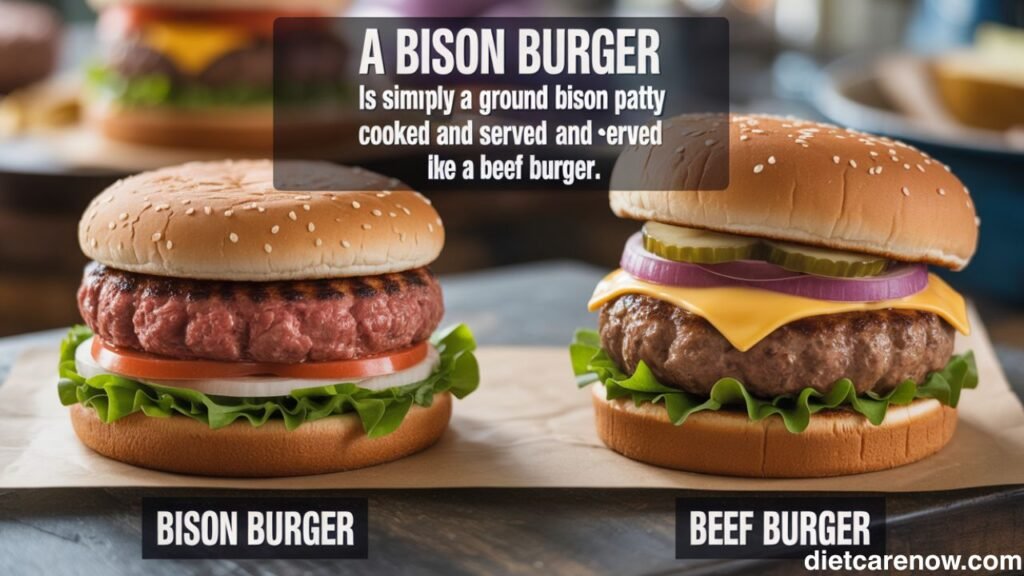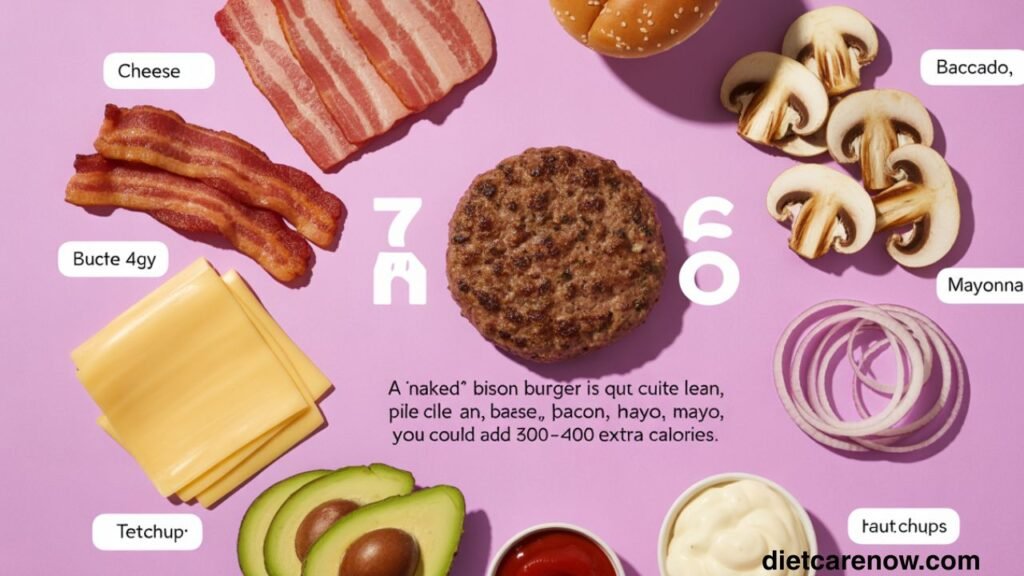If you’ve noticed bison burgers popping up on menus or in the freezer section of your grocery store, you’re not alone. Bison meat has been gaining popularity both in restaurants and home kitchens. Many people are making the switch from beef to bison, drawn by its reputation for being leaner, lower in calories, and still full of flavor.
But what does that really mean when you sit down to eat a bison burger? How many calories are you actually consuming, and how does it compare to the beef burger you might be used to? Let’s break it down.
What is a Bison Burger?
At its core, a bison burger is simply a ground bison patty cooked and served just like a beef burger. The main difference lies in the nutritional profile and flavor.
- Taste & Texture: Bison has a rich, slightly sweet taste without the heavy greasiness you sometimes get from beef. It’s tender but not overly fatty.
- Cooking Style: Because bison is leaner, it cooks faster and can dry out if overdone. Most chefs recommend cooking it to medium for the best flavor and juiciness.
The result is a burger that feels lighter yet still satisfying.
Also read: /wild-edible-greens/

Calorie Count in a Standard Bison Burger
The calories in a bison burger depend on the patty size and how it’s prepared. Here’s the breakdown for cooked meat without any buns or toppings:
- 4 oz. cooked bison patty: about 190–200 calories
- 6 oz. cooked bison patty: about 280–300 calories
For comparison:
- 4 oz. cooked beef patty (80% lean): around 290 calories
- 6 oz. cooked beef patty (80% lean): around 430 calories
So right away, you can see that bison tends to be leaner and lower in calories than a traditional beef burger of the same size.
Nutritional Profile of Bison Meat
Bison isn’t just lower in calories. It also offers a solid nutritional boost.
- Protein: High-quality protein, about 22 grams per 4 oz. cooked portion.
- Fat: Less total fat and saturated fat compared to beef.
- Cholesterol: Slightly lower than beef, though still present.
- Vitamins & Minerals: Rich in iron, zinc, vitamin B12, and selenium.
- Omega-3s: More omega-3 fatty acids than standard beef.
This combination makes bison an attractive option for people who want nutrient-dense red meat without the calorie overload.
Bison Burger vs Beef Burger Calories
Side by side, the calorie difference is clear:
| Burger Type | 4 oz. Patty | 6 oz. Patty |
|---|---|---|
| Bison | 190–200 | 280–300 |
| Beef (80/20) | ~290 | ~430 |
If your goal is weight management, bison gives you a leaner foundation without sacrificing flavor.
Impact of Cooking Methods on Calories
How you cook your bison burger matters:
- Grilled or broiled: Lowest calorie option since fat drips away.
- Pan-fried: Can add 40–100 extra calories if you use oil or butter.
- Air-fried: Keeps it lean, similar to grilling.
Tip: Seasoning lightly with herbs, spices, or a splash of olive oil adds flavor without significantly increasing calories.
Calories in Popular Bison Burger Toppings
The patty is just the beginning. Toppings can double or even triple your calorie count.
- Cheddar cheese slice: ~110 calories
- Bacon (2 strips): ~80 calories
- Avocado (2 slices): ~50 calories
- Grilled mushrooms/onions: ~25–40 calories
- Mayonnaise (1 tbsp): ~90 calories
- Ketchup/mustard: 20–40 calories
A “naked” bison burger is quite lean, but pile on cheese, bacon, and mayo, and you could add 300–400 extra calories.

Bison Burger Buns and Calorie Impact
The bun makes a big difference:
- White bun: ~150–180 calories
- Whole wheat bun: ~170–200 calories (with more fiber)
- Lettuce wrap: virtually calorie-free alternative
- Low-carb/keto bun: varies, usually 50–120 calories
Choosing your bun wisely can help keep your burger lighter and more balanced.
Calories in Restaurant-Style Bison Burgers
At restaurants, portion sizes are often oversized:
- Gourmet bison burger with cheese and fries: 700–1,200 calories
- Chain restaurant bison burger: 600–1,000 calories, depending on toppings
The hidden calories usually come from buttered buns, sauces, and larger patties.
Homemade Bison Burger Calories
Cooking at home gives you more control:
- Stick to 4–5 oz. patties for a reasonable portion.
- Use whole wheat or lettuce wraps instead of high-calorie buns.
- Add fresh toppings like lettuce, tomato, and grilled veggies.
A homemade bison burger can stay around 300–450 calories total if built thoughtfully.

Bison Burgers for Weight Loss
Because they’re lean, bison burgers can fit into a weight-loss plan. The key is portion control and balancing your plate with vegetables or a side salad instead of fries.
Protein-rich meals like bison burgers also help you feel full longer, which can reduce overeating later.
Are Bison Burgers Heart-Healthy?
Bison contains less saturated fat than beef, making it friendlier for heart health. It’s also a great source of iron and zinc, which support healthy blood and metabolism.
Research suggests that lean red meats like bison, when eaten in moderation, can be part of a heart-conscious diet.
Keto, Paleo, and High-Protein Diets with Bison Burgers
Bison burgers fit perfectly into low-carb, high-protein diets:
- Keto: Skip the bun, load up on cheese, avocado, and low-carb toppings.
- Paleo: Stick to lettuce wraps and natural seasonings.
- High-Protein: A 6 oz. patty alone gives you almost 40 grams of protein.

Tips to Reduce Calories in Bison Burgers
If you want to enjoy bison burgers without going overboard, try these swaps:
- Use lettuce wraps or thin sandwich buns.
- Swap cheese for avocado or grilled veggies.
- Choose mustard or salsa over mayo-based sauces.
- Grill instead of pan-frying.
- Stick to lean, 90% or higher ground bison.
These small adjustments can save you 150–300 calories per burger.
Conclusion: Should You Add Bison Burgers to Your Diet?
A bison burger is a flavorful, lean alternative to beef that’s naturally lower in calories and packed with nutrients. When cooked properly and paired with smart toppings, it can fit into almost any diet—from weight loss to high-protein plans.
The bottom line: if you love burgers but want a lighter, nutrient-dense option, bison is worth adding to your menu. Just keep an eye on toppings and buns, and enjoy it as part of a balanced diet.

